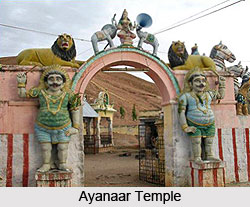 Terracotta Art in Tamil Nadu is basically famous for the splendid six metre high horses. Shrines to Ayanaar are very common in the state of Tamil Nadu. In the temples of Ayanaar life-sized terracotta horses have been placed at the shrines to provide transportation for Ayanaar`s spirit soldiers, enabling them to travel through the villages and fields at night to right against evil.
Terracotta Art in Tamil Nadu is basically famous for the splendid six metre high horses. Shrines to Ayanaar are very common in the state of Tamil Nadu. In the temples of Ayanaar life-sized terracotta horses have been placed at the shrines to provide transportation for Ayanaar`s spirit soldiers, enabling them to travel through the villages and fields at night to right against evil.
The styles of the horses vary from area to area: some are more realistic or more abstract but they are all complete with harness and reins and have the appearance of being `ready to go` at a moment`s notice. Because the potter`s primary function is to make vessels for the village, the sculptured forms are dictated by the techniques of pot making and are formed by coiling, beating and modelling.
Some shrines of the Ayanaar temple are small, containing just a few statues and horses; others may be spread out over a large area of an acre or so, with a central temple building containing the major gods. Outside the temple sometimes are rows of horses, bulls, statues of deities and soldiers, as well as domestic animals and household pests such as snakes and rats, all are made from terracotta. The large horses which are found in the temples are in fact the largest terracotta sculptures ever known.
 The towering horses are monumental and powerful. Their sheer size and force of numbers, maybe as many as several hundred, invites a response of great reverence for the skill of the potters who made them. A strong sense of the cycle of birth and death, of creation and destruction, is all-pervading, as the terracotta`s can be seen at every stage - the most recently offered are still covered with paint, and the oldest are crumbling into sherds in the process of being re-absorbed into the earth.
The towering horses are monumental and powerful. Their sheer size and force of numbers, maybe as many as several hundred, invites a response of great reverence for the skill of the potters who made them. A strong sense of the cycle of birth and death, of creation and destruction, is all-pervading, as the terracotta`s can be seen at every stage - the most recently offered are still covered with paint, and the oldest are crumbling into sherds in the process of being re-absorbed into the earth.
The custom in Tamil Nadu is that after the festival the terracottas are left at the shrine where they will remain to become eroded through time, their function of being presented to and accepted by god completed. The shrines represent a kind of graveyard of offered horses, elephants, bulls and figures which arc pushed back each year to make space for new donations.
Gradually the art of terracotta in Tamil Nadu is being replaced by cement animals and figures which will be more permanent and not require the ever decreasing resources of clay and wood.



















